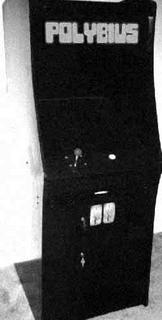Videogames, Sensory Deletion, and The Shadow Government
Videogames have been in the mainstream for over 30 years now, yet it seems we still can’t get through a year without the news media telling us “Those dadgum Intendo tapes are ruinin’ the chillin’s minds.”
Well, what if they’re right? What if there’s a game whose purpose is to burn away any capacity for dissent within you and transform you into a complaisant drone, devoid of any dreams, goals, or ambition, satisfied with whatever life hands you like a good do-bee?
The story of the mysterious arcade game Polybius suggests that this could be the case.
The Story
In 1981, a mysterious arcade cabinet suddenly started popping up around the suburbs of Portland, OR. The cabinet was solid black with one button, one joystick, and a marquee that read “Polybius.” Soon after it appeared, people started playing the machines and were immediately hooked. Word spread quickly, and lines constantly formed around the machines with people eager to play again. Owners of establishments which had these machines reported visits from mysterious men in black who would not collect marketing information or even quarters from the machines—they would only collect unknown data and leave. People who played Polybius reported that they experienced night terrors, amnesia, insomnia, memory loss, and even an inability to feel sadness1. The game is said to even be directly responsible for a few cases of suicide. Then, as suddenly as the machines appeared, they were gone. Many people who played the games eventually developed an aversion to videogames, and one even became an anti-videogame activist.
The first pieces of evidence for Polybius‘s existence were limited to this screenshot of the main screen:
And this black-and-white photo of a Polybius cabinet:
The cabinet picture corroborates reports that it was an all-black cabinet with simplistic controls. The screenshot gives little information except for introducing the game’s designer, Sinnesloschen Inc. (which translates from German as “Sensory Delete”).
The Internet Has Their Say…
The story spread across the Internet in the early 2000s and, though its origins are not certain, the legend is thought to originate from a Usenet post. Eventually the story gained such notoriety that it even enjoyed a brief reference in an episode of The Simpsons.

The Internet being as it is, rumors started flying fast and furious with leads on Polybius‘s origins and where it is now.
Many people claimed to have a copy of the original Polybius ROM, but all of them refused to release it, most saying that, the budding philanthropists that they are, they were afraid of the adverse health effects they may loose upon the world. How thoughtful. (Though, a recreation of how people thought the game would play is available at http://www.sinnesloschen.com/, a Polybius tribute site.)
The game was said to have been developed by Ed Rotberg (Battlezone), though stories have surfaced that Atari and possibly Sega were also involved. Some claimed that Polybius’s gameplay was similar to Atari’s Tempest, except that it utilized strobe effects, and instead of you moving your character directly, it was the entire maze around it that moved, creating an optical tunnel effect.
One piece of information that was uncovered and has been largely accepted as part of the Polybius mythos comes from a 2006 comment that appeared on CoinOp.com’s Polybius entry that purported to be written by Steven Roach, who identified himself as part-owner of Sinnesloschen. To summarize his post, Sinnesloschen was allegedly contracted by an unnamed company from the southern United States to develop a game they had an idea for. A story is told with great detail to attention about working environments, contracts, etc. Skip ahead a bit and the writer discusses a story about a kid who suffered an epileptic fit due to Polybius. However, they settled out of court, so no documentation exists. The “men in black” described in the story were explained as being company directors assessing the machines. If you want to read the full post, it’s on the coinop.com listing for Polybius in the comments on this page.
Coinop.org reported in 2009 that they were going to Ukraine to research a lead they got about Polybius, and that they would report on their findings once they got back. Three years later nothing has been posted. I’ve contacted Coinop.org but have not received a response as of the time of publishing. If they get back to me afterward I will update this article with any information they give me.
…And Nothing of Value Was Gained
All this information is great and all, and it’s a cool story—but does it hold water? First thing’s first, we have to separate the wheat from the chaff and figure out, of the information provided after the story was posted, how much is legit.
Let’s take a look at the two pictures that were originally released—the cabinet and the screenshot. Considering how easy these would be to Photoshop, it’s hard to call them evidence at all, so those are out.
But what of Ed Rotberg of Battlezone fame’s involvement? Well, it turns out he’s been interviewed about this before, so take it from the man himself:
“…I can state with confidence that I never saw or heard of, and certainly never worked on any game called Polybius. I understand that my name has somehow gotten connected to this game (if it ever existed), and have even seen some sites that purport to show the screen display, ‘game play’, etc. I have had nothing to do with any of those.” – Ed Rotberg2
So there goes Ed. We’re almost back to where we started, except for one thing: Steven Roach. If you read the story, it’s very detailed—but that’s what I think tarnishes its credibility. The story is too detailed, like the author was really trying to anchor himself into the Polybius story and win over skeptics with a glut of facts. The fact that they worked in portacabins, details on what district of Portland the kid who had an epileptic fit lived in, the fact that playtesting figures were collated—are these the details you’d include if you were telling the story? Ones you’d consider important? Hell, after 25 years are these even details you’d remember?
Coinop.org seems to agree.
“Quick update, we just wanted to go on record here that Steven Roach is full of himself, and knows nothing about this game. We have it on good authority. No, Polybius is not a Tempest prototype. No, Polybius is not a vector game. Does the title screen look vector? No, it does not.”– coinop.org May 16, 2009.3
These, however, are just opinions, not proof. I searched around the Internet for proof of Steven Roach’s identity and finally found it at the Retrogamer.net forums4.
It was a 150-post discussion, so I’ll give you the play-by-play:
- Steven Roach (Stevenroach) posts the same “I want to clear things up” spiel.
- User, Space_Ace and others reply that they are skeptical.
- Stevenroach answers some questions and says he may have more proof, but he will have to dig it up/get legal clearances.
- Users ask what the game was about.
- Stevenroach evades that “What’s the game about?” question for about three posts. After being grilled a bit, he divulges the info. It was action based but with number puzzles.
- Stevenroach gives the full backstory on the Sinneslöschen name—it was blurted out at the last minute by a co-worker when they were on the phone with their lawyer and needed to quickly come up with a business name.
- Enter Porkpie, a user that immediately defends Stevenroach and demands people being skeptical of him to apologize.
- Enter Baxter, a man with a background in the game industry who discusses why Polybius is very plausible and compliments Stevenroach’s writing.
The conversation died for a few months at this point, so I feel this is a good time for me to comment on something I thought was very strange. If you buy this story, then this means that the company, Sinnesloschen, which means “Sensory Delete” in German, accidentally made a videogame that allegedly deletes senses. If that’s the case, I’m going to start a company with this Steven Roach guy and we’re going to name it after the German words for “Blow Jobs and Ice-Cream Sundaes,” and see what happens.
Also, if you look at the conversation, people really had to grill him to get any information out of him about the game. Even very vague information—people were saying “just tell me if it was puzzle or action,” and it took quite a while for him to come out with it. That’s suspicious for someone who wanted to “set the record straight.”
Anyway, skip ahead a few months; the thread is revived and someone notices something important: that Stevenroach, Space_ace, Porkpie and Baxter—the most active commenters in the thread—have a suspiciously similar writing style. (And they do. Stevenroach, Space_ace and Porkpie, for example, all double space at the end of their post and sign their name. That’s uncommon in forums.) A mod researches and verifies that Stevenroach, Space_ace, Porkpie and Baxter are all coming from the same IP.
I’d say this pretty well debunks the whole Steven Roach story, but I’m nothing if not a good skeptic, so I’ll entertain the idea that it’s possible that the Stevenroach commenting on those forums isn’t the same as the original one from the Coinop.com messages. This seems a bit unlikely, though—the writing styles between the retrogamer.net and coinop.org personalities are very similar. His writing is reasonably eloquent, but a giveaway is that it’s overly descriptive, a desperate attempt to make his story seem anchored in reality. However, I think the case-closer here is the more damning fact that the retrogamer.net user Space_Ace, who was later found to be Stevenroach, registered his handle on March 17, 2006, three days before the Steven Roach post appeared on CoinOp.com. This soundly puts to bed the notion that Steven Roach plays a part in this story any greater than tacking a hoax backstory onto the original legend.
The Shadow Government: Malicious, Cunning, but Not Too Bright

A hobbyist’s recreated Polybius cabinet.
The biggest problem with the Polybius story itself and the data-harvesting G-men is one that is common to many the-government-is-evil-and-out-to-get-me conspiracy theories—it postulates the existence of an incredibly sly, technologically-advanced shadow government that is at the same time an evil genius capable of launching a mind-control device right under the public’s nose without their knowledge, and a bumbling moron so stupid that it achieved exactly zero of its goals. Add to this the fact that they supposedly have these amazing resources, yet they somehow didn’t have anyone talented enough to code the game in-house, so they had to outsource it to Sinneslöschen. Correct me if I’m wrong, but I’m pretty sure that rule number one in the Secret Evil Organization Handbook is “be self-contained.” Since they purportedly weren’t self-contained, this means they had no real control over the code of the game, so they would have had to actually explain to the coders at Sinneslöschen “Yes, we want it to be similar to Tempest, except this one erases all senses and life goals from the person playing it and gives them a feeling of lobotomized contentedness for the rest of their lives. Oh, and a love for toil, if you can fit it in.” Also, I’m no military strategist, but I’m pretty certain that the CIA almost certainly wouldn’t want other countries to know how our super-advanced mind-control devices work—that just seems like national security 101.
This brings me to the fact that Sinnesloschen means “sensory deleting,” which I’ve touched upon a bit already. Now the U.S. may be a pretty unilingual country on the whole, but if people were lining up to play this game at multiple locations for several weeks, then simple probability dictates that AT LEAST one person would know enough German to know what that says. They might not think anything of it at the time outside of “what a weird name for a company,” but later when they’re waking up screaming, having forgotten their childhood, unable to feel normal emotions, they might look back at that and think “You know, that might have been more literal than I initially thought.”
Also, regarding the men in black not taking the quarters—of course they wouldn’t. Generally, the game company doesn’t collect the quarters; the owners of the establishment the machine is in does. Then they usually write a check to the game company for the licensing/rental fees.
The Verdict
Some people say that the Polybius legend came about from a seed of truth: that a game in the 1980s (possibly a prototype of Tempest itself) caused epileptic seizures in those who played it, and the mystique of “men in black” and more creepy symptoms eventually were added to the story. Though that may have happened, frankly, I don’t believe that the Polybius myth is based on any truth at all. I will, however, admit that I believe something is missing in the story. If it began on Usenet, I think it’s been retold so much that a crucial piece was left out in the re-tellings—something tied to the game’s namesake, Polybius, an ancient Greek historian. You see, Polybius wasn’t just a historian; he was also a budding cryptographer, inventing a decoding tool named for him called the Polybius square.

A normal Polybius square, used for deciphering codes.
Maybe I’m just reading too deep into it, but this fact seems too good to be coincidence. Why choose Polybius, an obscure Greek historian, to name the game in your story after? Even Sinnesloschen means something related to the story, so it seems out of place for the game itself to be a completely randomly chosen name. I think there was a big punchline/scare at the end of the story that required the reader to recognize a code and decode it. However, even with that addition, since all the evidence crumbles upon any kind of inquiry, the story is still 100% fiction.
Some people ask “If the story is fake, why would someone just make it up?” Just a passing glance at YouTube will show what some people are willing to do for the chance at a soupçon of fame. Create a creepy enough story on Usenet or wherever, and you can take pride every time you hear about it online, in the news, or even in The Simpsons.
But even if somebody did dig up a legitimate ROM, I highly doubt that any videogame could have such a profound effect on one’s psyche that–
ALL GLORY TO POLYBIUS.
ALL GLORY TO POLYBIUS.
ALL GLORY TO POLYBIUS.




Man. I love conspiracy theories. Why can’t real life actually be this interesting?
I think I downloaded this for MAME once.
I read this alone, in my living room, at night and now I’m scared. I think I will have to play ‘Googly Eyes’ on the Kinect to take my mind off the creepy black and white photo of the cabinet. It’s the only game shallow enough.
Oh Googly Eyes, don’t look so surprised…
…I will put you on stuff! Put you on a small rock, now that small rock can talk. What does it say, say, say?
It’s my favourite. I think it’s your favourite too!
Yay! I have another scary one lined up in the future.
Thumbs up!
Great article I wonder how much this guy was laughing when he did this
Found this on the Wikipedia page for Polybius (the game). Not sure if it’s a coincidence (a subtle clue, perhaps?), but it’s pretty good:
“Polybius gets its name from the Greek historian who was known for his assertion that historians should never report what they cannot verify through interviews with witnesses…” (emphasis added)